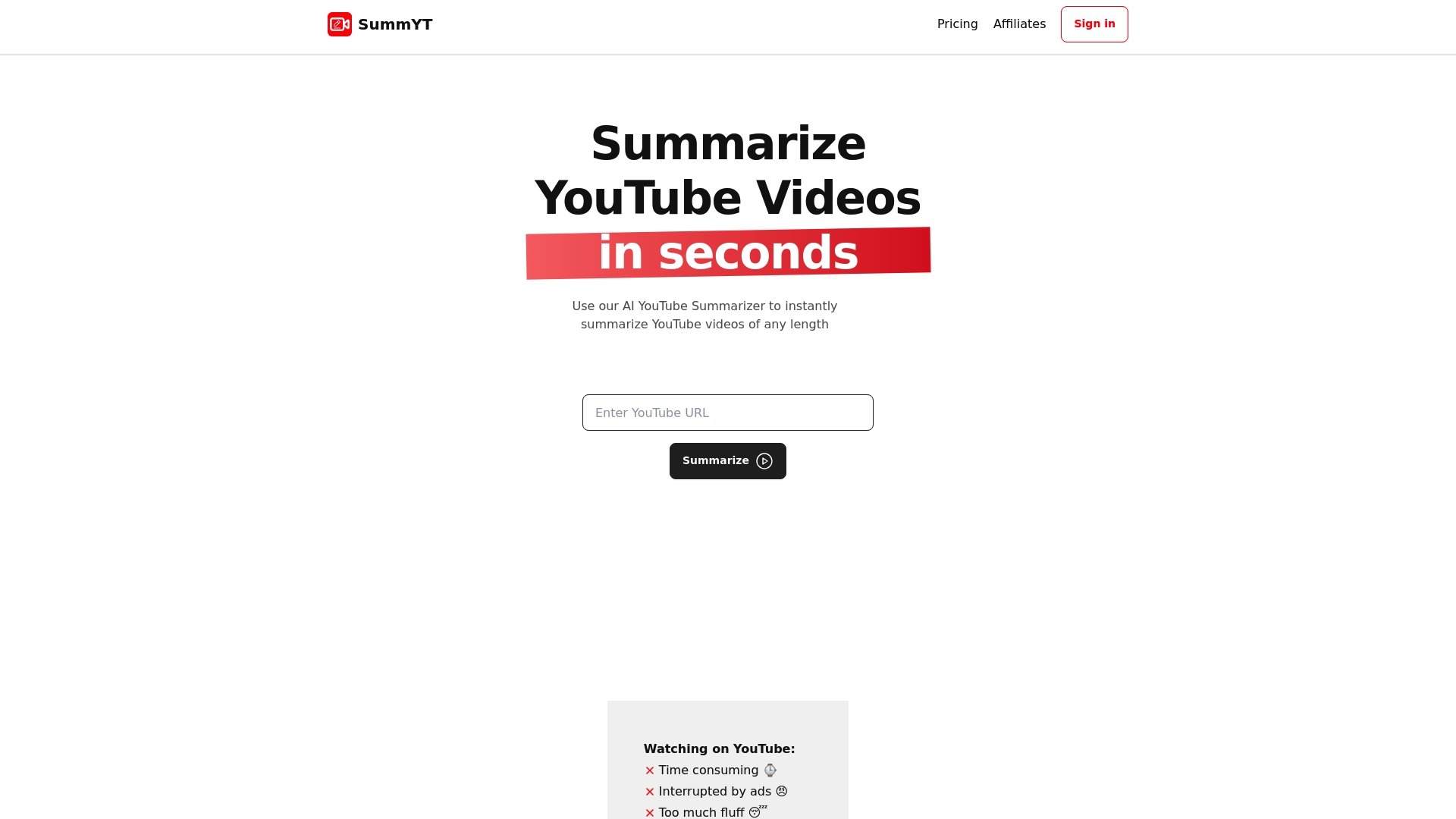10 Essential Tips for Efficient Video Research

Video research often feels overwhelming with endless content and a constant risk of wasting hours. Yet, research from Harvard Business Review shows that having well structured goals can reduce information overload by up to 40 percent. This surprises many, because the real secret to smarter video research is not about watching more content or using expensive tech—it is all about purpose and focus right from the start.
Table of Contents
- Define Your Research Goals Clearly
- Utilize Reliable Video Research Tools
- Organize Your Research With Folders
- Take Effective Notes While Watching
- Summarize Key Points For Quick Reference
- Evaluate Video Credibility And Source
- Use Transcripts For Easier Information Access
- Collaborate With Others For Broader Insights
- Keep Your Research Up-To-Date
- Practice Ethical Research And Citing Sources
Quick Summary
| Takeaway | Explanation |
|---|---|
| Define clear research goals | Establish specific, measurable, and time-bound objectives to keep research focused and efficient. |
| Utilize reliable video research tools | Choose tools with advanced features that streamline information extraction and improve productivity during research. |
| Organize research with structured folders | Implement a logical folder system to manage materials effectively and enhance retrieval speed for critical insights. |
| Take strategic notes while watching | Focus on key insights and concepts during video viewing to create meaningful notes that aid retention and understanding. |
| Practice ethical research and citing sources | Maintain integrity by properly attributing sources and adhering to copyright standards to support academic credibility. |
1: Define Your Research Goals Clearly
Successful video research begins with crystal clear objectives. Without well defined goals, you’ll waste time wandering through irrelevant content, consuming hours without meaningful progress. Your research goals act as a strategic compass, directing your efforts precisely where they need to go.
Before diving into video content, ask yourself critical questions that will sharpen your research focus. What specific knowledge or insights are you seeking? Are you conducting academic research, preparing for a presentation, gathering market intelligence, or exploring a personal interest? Each purpose demands a unique approach and research strategy.
Effective research goals typically have several key characteristics:
- Specificity: Narrow down your research scope to precise topics or questions
- Measurability: Establish clear indicators of successful research completion
- Time-bound: Set realistic timeframes for your research process
Consider breaking down broad research objectives into smaller, manageable sub goals. For instance, if you’re researching climate change impacts, you might segment your goals into economic effects, environmental consequences, and potential mitigation strategies.
According to Harvard Business Review, well structured research goals can reduce information overload by up to 40%. By maintaining laser focused objectives, you transform video research from an overwhelming task into a streamlined, productive process.
Professional researchers recommend creating a research roadmap that outlines your primary objectives, expected outcomes, and potential sources. This strategic document helps you stay organized and prevents unnecessary detours during your video research journey.
2: Utilize Reliable Video Research Tools
Transforming video research from a time consuming process into an efficient workflow requires leveraging powerful digital tools. Modern researchers have access to an array of sophisticated platforms designed to streamline information gathering, analysis, and comprehension.
The right research tools can dramatically reduce the time spent watching entire videos by enabling quick insights and targeted information extraction. When selecting video research tools, focus on platforms that offer robust features like advanced search capabilities, transcript generation, and content summarization.
Key considerations when choosing video research tools include:
- Speed of information retrieval
- Accuracy of content extraction
- Compatibility with multiple video platforms
- User friendly interface
Advanced video analysis techniques can significantly enhance your research efficiency. Professional researchers recommend using tools that provide multiple modes of content consumption such as transcripts, summaries, and keyword highlighting.
According to Gartner Research, organizations that implement specialized research tools can improve information processing speed by up to 60%. These tools help professionals quickly filter through vast amounts of video content, extracting precise information without watching entire recordings.
While numerous tools exist, prioritize platforms that integrate seamlessly with your existing workflow. Look for solutions offering features like time stamped notes, clip extraction, and cross platform compatibility. Efficiency is about working smarter, not just faster, and the right tools can be transformative in your video research strategy.
3: Organize Your Research with Folders
Strategic organization transforms chaotic research into a streamlined, productive process. Developing a systematic folder structure is crucial for managing video research materials efficiently, preventing information overload and ensuring quick retrieval of critical insights.
Think of your research folders as a digital filing cabinet where each drawer represents a specific research category or project. By implementing a clear, logical organizational system, you create a roadmap that guides your research and saves substantial time during later stages of information compilation.
Effective folder organization involves several strategic approaches:
- Hierarchical Structure: Create main categories with specific subcategories
- Consistent Naming Conventions: Use clear, descriptive folder and file names
- Date Stamping: Include research dates to track information chronology
Researchers often underestimate the power of meticulous organization. How to Outline Video Reports for Clear Presentations provides additional insights into structuring research materials effectively.
According to McKinsey Global Institute, professionals spend approximately 20% of their workweek searching for information. Robust folder systems can dramatically reduce this wasted time, enabling more focused research and analysis.
Consider developing folder structures that align with your research goals. For academic research, you might create folders by research topic, source type, or chronological period. Professional market researchers could organize folders by industry, company, or research objective.
Digital tools like cloud storage platforms and specialized research management software offer advanced tagging and search functionalities that further enhance your organizational strategy. The key is creating a system that feels intuitive and supports your unique research workflow.
4: Take Effective Notes While Watching
Strategic note taking transforms passive video watching into an active learning experience. Effective note taking requires more than simply transcribing content verbatim it demands selective capturing of key insights, critical concepts, and actionable information.
The goal is to create a concise, meaningful record that synthesizes the video’s most valuable information. Selective attention becomes your primary research skill, allowing you to filter through substantial content and extract precisely what matters.
Professional researchers recommend several core strategies for efficient note taking:
- Focus on main arguments and core concepts
- Use abbreviations and symbols to increase writing speed
- Capture unique perspectives and novel insights
- Record timestamps for critical segments
Understanding Efficient Note Taking Guide offers additional techniques for transforming your research approach. By developing a systematic note taking method, you convert video content from passive consumption into active knowledge acquisition.
According to Cornell University’s Learning Strategies Center, effective note taking can improve information retention by up to 34%. This dramatic improvement stems from actively processing and synthesizing information rather than passively receiving it.
Consider using digital tools that support real time note taking with features like timestamp linking, color coding, and instant searchability. Technological assistance can dramatically enhance your research efficiency, allowing you to capture insights without disrupting your viewing experience.
Remember that great notes are not about quantity but strategic quality. Prioritize understanding over exhaustive documentation, focusing on concepts that directly relate to your research goals.
5: Summarize Key Points for Quick Reference
Summarization transforms complex video content into digestible knowledge, enabling faster comprehension and more efficient information retention. The art of creating concise, meaningful summaries is a critical skill for researchers seeking to extract maximum value from their video research.
Effective summaries go beyond simple transcription they capture the essence of the content, distilling complex ideas into clear, actionable insights. Think of summaries as intellectual shortcuts that preserve the core message while eliminating unnecessary details.
Professional researchers recommend several key strategies for creating powerful summaries:
- Identify the central thesis or main argument
- Extract specific examples that illustrate key points
- Note significant statistics or research findings
- Capture unique perspectives or novel insights
Understanding Why Concise Summaries Matter provides deeper insights into the art of effective summarization. By mastering this skill, you transform hours of video content into rapid reference materials.
According to Stanford University’s Learning Research Center, students who consistently create summaries improve information retention by up to 50%. This dramatic improvement stems from active engagement with the material, forcing your brain to process and synthesize information.
Consider utilizing digital tools that support automatic summarization and annotation. Technology can significantly accelerate your summary creation process, allowing you to generate quick references without manually reviewing entire videos.
Remember that a great summary is not about length but precision and clarity. Your goal is to capture the most important information in the most compact form possible, creating a powerful reference tool for future research and understanding.
6: Evaluate Video Credibility and Source
Source verification is the cornerstone of reliable research, transforming random video content into credible information. Not all video sources are created equal, and discerning researchers must develop a critical eye for distinguishing high quality content from misleading or unreliable materials.
Navigating the vast landscape of online video requires a strategic approach to source evaluation. Credibility is not about popularity, but about substantive, verifiable information. Professional researchers employ multiple techniques to assess video reliability and authenticity.
Key criteria for evaluating video source credibility include:
- Author credentials and professional background
- References and citations within the video
- Alignment with current academic or scientific consensus
- Transparency of research methodologies
Master Step by Step Video Analysis provides advanced techniques for comprehensive source assessment. Understanding how to critically analyze video content can dramatically improve the quality of your research findings.
According to MIT’s Media Literacy Project, approximately 70% of online video content contains some form of bias or incomplete information. Developing robust evaluation skills becomes crucial in filtering out potentially misleading sources.
Consider examining multiple indicators of credibility. Look beyond surface level metrics like view count or subscriber numbers. Examine the creator’s expertise, the depth of their arguments, and the quality of their supporting evidence.
Cross referencing information with multiple reputable sources can help validate the credibility of video content. This approach ensures a more comprehensive and balanced understanding of the topic, protecting your research from potential misinformation.
7: Use Transcripts for Easier Information Access
Transcripts are powerful research tools that transform video content into easily searchable, quickly scannable text. They provide researchers with a strategic advantage, enabling faster information extraction and comprehensive analysis without repeatedly rewatching entire video segments.
Transcripts offer multiple advantages beyond simple text conversion. They democratize information access, particularly for researchers with hearing impairments or those working in multilingual environments. By converting spoken content into written format, transcripts expand comprehension and research possibilities.
Key benefits of utilizing video transcripts include:
- Rapid keyword and concept searching
- Easy copy and paste for note taking
- Improved comprehension through visual and textual learning
- Enhanced accessibility for diverse researchers
Understanding the Multilingual Video Summarization Guide provides additional insights into leveraging transcript technologies for comprehensive research.
According to Harvard Business Review, professionals using transcript technologies can reduce research time by up to 45%. This dramatic efficiency gain stems from the ability to quickly scan, search, and extract precise information.
Modern researchers should explore advanced transcript tools that offer features like timestamp linking, multilingual support, and automated summarization. Technology has transformed transcripts from passive documents into dynamic research instruments.
When selecting transcript resources, prioritize accuracy, formatting options, and compatibility with your existing research workflow. A high quality transcript becomes more than just text it becomes a strategic research asset that accelerates your information gathering process.
8: Collaborate with Others for Broader Insights
Collaborative research transforms individual efforts into collective intelligence, expanding the boundaries of knowledge acquisition beyond personal limitations. By engaging with peers, experts, and diverse perspectives, researchers can unlock deeper understanding and uncover insights that might remain hidden when working in isolation.
Collaboration is not merely about sharing information it is about creating a dynamic knowledge ecosystem where different perspectives intersect, challenge, and enrich each other. Collective intelligence amplifies research potential, allowing researchers to leverage diverse expertise and experiences.
Strategic collaboration approaches include:
- Participating in online research forums
- Joining professional research communities
- Engaging in peer review discussions
- Sharing annotated video research findings
Master Step by Step Video Analysis offers additional strategies for developing collaborative research techniques. Effective collaboration requires openness, mutual respect, and a genuine commitment to collective learning.
According to MIT Sloan Management Review, teams that effectively collaborate can improve problem solving capabilities by up to 60%. This significant enhancement stems from the cross pollination of ideas, perspectives, and methodological approaches.
Digital platforms have revolutionized collaborative research, enabling real time knowledge sharing across geographical boundaries. Virtual collaboration tools break down traditional research silos, creating opportunities for global knowledge exchange.
Remember that successful collaboration is not about consensus, but about creating a rich, nuanced understanding through respectful dialogue and intellectual diversity. By embracing collective insights, researchers can transcend individual limitations and achieve more comprehensive, robust research outcomes.
9: Keep Your Research Up-to-Date
Staying current is the lifeblood of effective research, transforming static knowledge into dynamic, evolving understanding. In an era of rapid information proliferation, researchers must develop systematic approaches to continuously refresh and validate their knowledge base.
Research is not a one time event, but an ongoing process of discovery, verification, and refinement. Emerging technologies, new academic findings, and shifting paradigms demand constant vigilance and adaptability. Your research methodology must be as flexible as the information landscape itself.
Strategies for maintaining research currency include:
- Setting up automated content alerts
- Regularly reviewing recent publications
- Attending webinars and virtual conferences
- Following thought leaders in your research domain
Understanding Multilingual Video Summarization Guide provides additional insights into staying informed across diverse knowledge platforms. Continuous learning becomes a strategic advantage in research effectiveness.
According to Pew Research Center, professionals who implement systematic update strategies can improve their information currency by up to 45%. This significant enhancement stems from proactive knowledge management techniques.
Technology offers powerful tools for research maintenance. Leverage AI driven content aggregation, subscribe to specialized newsletters, and create digital workflows that automatically flag new relevant content in your research domains.
Remember that updating research is not about consuming every piece of information, but about developing a discerning approach to identifying truly valuable, transformative insights. Cultivate a research mindset that prioritizes quality over quantity, ensuring your knowledge remains sharp, relevant, and meaningful.
10: Practice Ethical Research and Citing Sources
Ethical research is the foundation of academic integrity, transforming information gathering from a mere task into a responsible intellectual pursuit. Researchers carry a profound responsibility to maintain rigorous standards of attribution, respect intellectual property, and present information with transparency and honesty.
Citing sources is more than a procedural requirement it is a fundamental demonstration of academic respect and intellectual transparency. Proper attribution acknowledges the work of original creators, supports the broader academic ecosystem, and enables other researchers to verify and build upon existing knowledge.
Key principles of ethical research documentation include:
- Always provide clear source attribution
- Use accurate direct quotes
- Distinguish between original and referenced content
- Respect copyright and intellectual property rights
How to Outline Video Reports for Clear Presentations offers additional guidance on maintaining research integrity. Developing a systematic approach to source citation protects both the researcher and the broader academic community.
According to Academic Integrity, approximately 45% of research misconduct stems from improper citation and attribution practices. Understanding and implementing robust citation protocols is crucial for maintaining research credibility.
Modern research tools provide sophisticated citation management systems that can help streamline the attribution process. Leverage these technological solutions to ensure consistent, accurate source documentation, but never rely solely on automated systems.
Remember that ethical research is not about perfection, but about demonstrating consistent respect for intellectual work. By prioritizing transparency, accuracy, and proper attribution, researchers contribute to a more robust, trustworthy academic discourse.
The table below provides a comprehensive summary of the 10 essential tips for efficient video research covered in the article, including core actions, primary focus, and key benefits for each tip.
| Tip | Core Action or Focus | Key Benefit or Outcome |
|---|---|---|
| Define Clear Research Goals | Set specific, measurable, and time-bound objectives | Maintains focus, reduces information overload by up to 40% |
| Utilize Reliable Video Research Tools | Use advanced tools for extraction, search, and summaries | Streamlines workflow, boosts processing speed by up to 60% |
| Organize Research with Folders | Structure digital folders with logical categories | Enhances organization and speeds up information retrieval |
| Take Effective Notes While Watching | Capture key concepts, insights, and timestamps | Improves retention, supports active learning (up to 34%) |
| Summarize Key Points for Quick Reference | Distill main arguments, examples, and statistics | Enables fast review and increases retention by up to 50% |
| Evaluate Video Credibility and Source | Assess author credentials, citations, and evidence | Ensures accuracy and protects against misinformation |
| Use Transcripts for Easier Access | Leverage searchable transcripts and keyword search | Accelerates info extraction, saves up to 45% of research time |
| Collaborate for Broader Insights | Engage with peers and professional communities | Expands perspectives, improves problem solving by up to 60% |
| Keep Research Up-to-Date | Set up alerts and review latest content | Ensures current, relevant knowledge base (improves by 45%) |
| Practice Ethical Research & Citing | Attribute sources, use accurate quotes, respect IP rights | Maintains integrity and academic credibility |
Discover Effortless Video Research with SummYT
Cut through the overwhelm of endless videos and complicated research flows. If you want to stop wasting hours sorting, summarizing, and taking notes on lectures, webinars, or tutorials, SummYT is here to help. Our AI-powered YouTube summarizer instantly turns any video into clear, concise key points so you never have to rewatch or get lost in irrelevant content again.

See for yourself how fast research becomes when you can search video transcripts, organize findings, and summarize insights in seconds. Whether you are a student, professional, or lifelong learner, try SummYT for unlimited summaries and experience smarter, more productive video research today. Get started now and see why so many users are replacing hours of manual work with just a few clicks on SummYT.
Frequently Asked Questions
What are some effective strategies for taking notes while watching videos?
Taking notes while watching videos should focus on main arguments and core concepts, using abbreviations and symbols to increase writing speed. Additionally, capturing unique perspectives and noting timestamps for critical segments can enhance the usefulness of your notes.
How can I ensure the credibility of the videos I use for research?
To verify the credibility of video sources, consider the author’s credentials, check for references or citations within the video, and assess the alignment with current academic or scientific consensus. Always look for transparency in research methodologies to ensure reliability.
What tools can help in summarizing video content effectively?
Using digital tools that support automatic summarization and annotation can help create concise summaries quickly. Key strategies include identifying the central thesis, extracting illustrative examples, and capturing significant statistics or research findings from the video content.
How can I keep my video research up-to-date?
To keep your video research current, set up automated content alerts, regularly review recent publications, attend webinars, and follow thought leaders in your field. Staying proactive in updating your knowledge base is crucial to maintaining research effectiveness.



